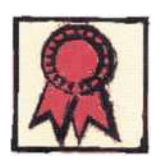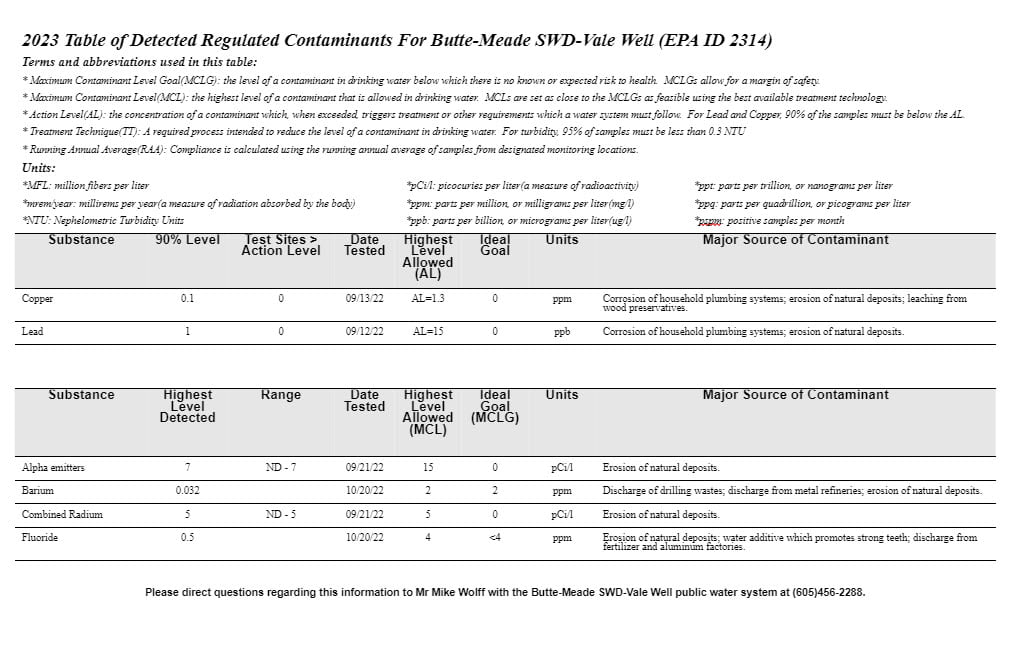BUTTE-MEADE SWD
2023 | Drinking Water Report
Contact us by calling (605)456-2288 or write us at PO Box 5 Newell SD 57760- 0005

WATER QUALITY
The Butte-Meade SWD has supplied twelve consecutive years of safe drinking water to the public it serves and has been awarded the Secretary’s Award for Drinking Water Excellence by the South Dakota Department of Environment and Natural Resources. This report is a snapshot of the quality of the water that we provided last year. Included are details about where your water comes from, what it contains, and how it compares to Environmental Protection Agency (EPA) and state standards. We are committed to providing you with information because informed customers are our best allies.
Water Source
We serve more than 345 customers an average of 119,000 gallons of water per day. Our water is groundwater that we produce from local wells. The state has performed an assessment of our source water and they have determined that the relative susceptibility rating for the Butte-Meade SWD-Vale Well public water supply system is low.
For more information about your water and information on opportunities to participate in public meetings, call (605)456-2288 and ask for Mike Wolff.
Additional Information
The sources of drinking water (both tap water and bottled water) include rivers, lakes’ streams, ponds, reservoirs, springs, and wells. As water travels over the surface of the land or through the ground, it dissolves naturally-occurring minerals, and can pick up substances resulting from the presence of animals or from human activity.
Contaminants that may be present in source water include:
- Microbial contaminants,such as viruses and bacteria, which may come from sewage treatment plants, septic systems’ agricultural livestock operations, and wildlife.
- Inorganic contaminants,such as salts and metals, which can be naturally-occurring or result from urban stormwater runoff, industrial or domestic wastewater discharges’ oil and gas production, mining, or farming.
- Pesticides and herbicides,which may come from a variety of sources such as agriculture, urban stormwater runoff, and residential uses.
- Organic chemical contaminants,including synthetic and volatile organic chemicals, which are byproducts of industrial processes and petroleum production, and can also come from gas stations, urban stormwater runoff, and septic systems.
Radioactive contaminants, which can be naturally-occurring or be the result of oil and gas production and mining activities.
In order to ensure that tap water is safe to drink, EPA prescribes regulations which limit the amount of certain contaminants in water provided by public water systems. FDA regulations establish limits for contaminants in bottled water which must provide the same protection for public health.
Drinking water, including bottled water, may reasonably be expected to contain at least small amounts of some contaminants. The presence of contaminants does not necessarily indicate that water poses a health risk. More information about contaminants and potential health effects can be obtained by calling the Environmental Protection Agency’s Safe Drinking Water Hotline (800-426-4791).
Some people may be more vulnerable to contaminants in drinking water than the general population. Immunocompromised persons such as persons with cancer undergoing chemotherapy, persons who have undergone organ transplants/ people with HIV/AIDS or other immune system disorders, some elderly, and infants can be particularly at risk from infections. These people should seek advice about drinking water from their health care providers. EPA/CDC guidelines on appropriate means to lessen the risk of infection by Cryptosporidium and other microbial contaminants can be obtained by calling the Environment Protection Agency’s Safe Drinking Water Hotline (800-426-4791).
If present, elevated levels of lead can cause serious health problems’ especially for pregnant women and young children. Lead in drinking water is primarily from materials and components associated with service lines and home plumbing. The Butte-Meade SWD public water supply system is responsible for providing high quality drinking water, but cannot control the variety of materials used in plumbing components. When your water has been sitting for several hours, you can minimize the potential for lead exposure by flushing your tap for 30 seconds to 2 minutes before using water for drinking or cooking. If you are concerned about lead in your water, you may wish to have your water tested. Information on lead in drinking water, testing methods, and steps you can take to minimize exposure is available from the Safe Drinking Water Hotline or at http://www.epa.gov/safewater/lead.
Detected Contaminants
The attached table lists all the drinking water contaminants that we detected during the 2023 calendar year. The presence of these contaminants in the water does not necessarily indicate that the water poses a health risk. Unless otherwise noted, the data presented in this table is from testing done January 1 – December 31, 2023 The state requires us to monitor for certain contaminants less than once per year because the concentrations of these contaminants are not expected to vary significantly from year to year. Some of the data, though representative of the water quality, is more than one year old.

